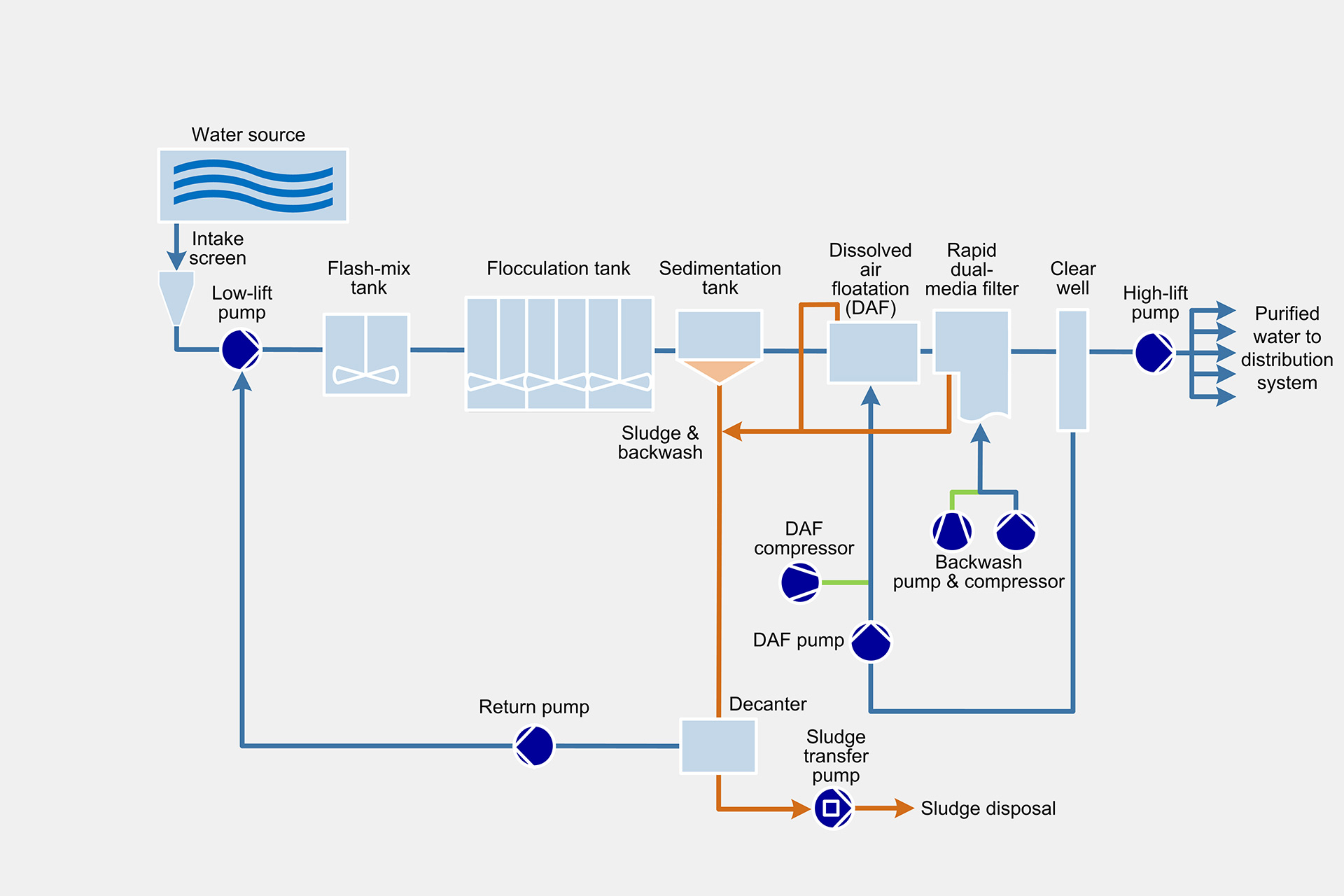The 10-Second Trick For Residential Water Purification Systems
Table of ContentsWhat Does Residential Water Purification Systems Mean?About Residential Water Purification SystemsResidential Water Purification Systems for BeginnersThe Buzz on Residential Water Purification SystemsThe Best Strategy To Use For Residential Water Purification SystemsThe 4-Minute Rule for Residential Water Purification Systems
A phosphorous substance is contributed to assist control rust of pipelines. This helps stop lead and also copper that may exist in pipelines from seeping into the water. As the water leaves the plant, ammonia is included in alter the chlorine to chloramine, a disinfectant that keeps a recurring in the circulation system against microbial contamination.All chemicals that are included are certified food grade, risk-free for usage in foods. Treated water is kept in deep below ground containers and also flows by gravity to pumping terminals and also into the distribution system. The circulation system contains 1,960 miles of water pipe ranging in diameter from 4" to 60".
Elimination of preference as well as odor substances from the water.: Softens the water.: Filtration to eliminate small fragments and also disinfection to kill viruses and germs, and make certain an unsuitable environment for virus and bacteria development throughout the circulation system (residential water purification systems).
Residential Water Purification Systems Things To Know Before You Get This
8 Stages of the Wastewater Refine Stage One Bar Screening Elimination of huge things from the influent to avoid damage to the center's pumps, shutoffs as well as other devices. The procedure of treating as well as reclaiming water from wastewater (any water that has actually been made use of in houses, such as flushing commodes, washing meals, or bathing, and also some water from commercial use as well as storm drains) begins with the assumption that after it is treated it will be clean sufficient to reenter the setting.
According to the EPA, The Clean Water Act (CWA) establishes the standard framework for managing discharges of toxins right into the waters of the USA and also regulating top quality criteria for surface area waters. Under the CWA, EPA establishes wastewater criteria for industry. The EPA has actually likewise created nationwide water high quality requirements recommendations for toxins in surface waters.
Associated White Documents Select Products Stage Two Testing Elimination of grit by flowing the influent over/through a grit chamber. Fine grit that locates its way into the influent needs to be eliminated to stop the damage of pumps and also devices downstream (or influence water flow). As well little to be screened out, this grit requires to be eliminated from the grit chamber.
The Greatest Guide To Residential Water Purification Systems
Stage 4 Aeration Air is pumped right into the oygenation tank/basin to urge conversion of NH3 to NO3 as well as offer oxygen for bacteria to remain to propagate and expand. As soon as converted to NO3, the microorganisms remove/strip oxygen particles from the nitrate particles and the nitrogen (N) is produced as N2 (nitrogen gas).
This starts in the aeration container. The key function of the oygenation container is to pump oxygen into the storage click resources tank to urge the breakdown of any natural product (as well as the development of the germs), in addition to make sure there is sufficient time for the organic material to be damaged down.
This procedure see is handled to offer the ideal conditions for bacterial development. Dissolved oxygen surveillance at this phase of the plant is vital. Ammonia and nitrate measurements are usual to determine just how effective the bacteria are in transforming NH3 to N2.
Residential Water Purification Systems Things To Know Before You Get This
Phase 5 Additional Clarifier Dealt with wastewater is pumped right into an additional clarifier to permit any type of remaining organic debris to resolve out of treated water flow. As the influent exits the aeration procedure, it moves right into a secondary clarifier where, like the key clarifier, any extremely tiny solids (or penalties) sink to the bottom of the tank.
Part of this triggered sludge is gone back to the oygenation container to increase the bacterial focus, help in propagation, as well as speed up the failure of natural material. The unwanted is discarded (residential water purification systems). The water that flows from the additional clarifier has considerably lowered natural product and also needs to be coming close to anticipated effluent requirements.
With the boosted focus of microorganisms as component of the aeration stage, there is a requirement to evaluate the outbound effluent for bacteria presence or absence and to disinfect the water. This guarantees that greater than defined concentrations of germs are not released into the environment. Chlorination is one of the most usual and cost-effective sort of sanitation yet ozone and UV sanitation are additionally boosting in popularity.
Top Guidelines Of Residential Water Purification Systems
Water is routed from the Head Storage Tank to the Claricone clarifier. Water enters the clarifier at the blending zone located in all-time low of the Claricone. Lime is included to the water in this zone where it why not try here reacts with the calcium and also the magnesium in the water to develop precipitates.



After sufficient time, fragments adhere to each various other and expand into bigger bits, or, floc, which is susceptible to resolve in water. Information of water is achieved by the seperation of put on hold solids from water by gravity.
The made clear water moves upward slowly, at some point passing over the effluent weir to the cone outlet and also on the to filters for additional therapy. The water plant includes a single phase lime softening operation to get rid of hardness. Firmness is brought on by the existence of liquified bivalent and polyvalent metal ions, mostly calcium and magnesium.
The 9-Minute Rule for Residential Water Purification Systems
This is included both in the clearwell as well as the high solution discharge as water goes into the distribution system. 2 mg/l is typically preferable in the plant faucet.